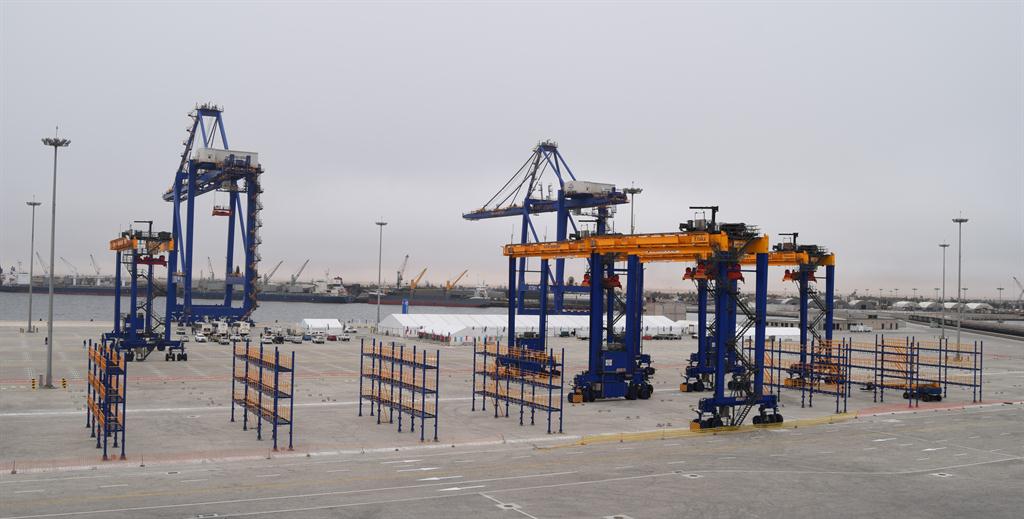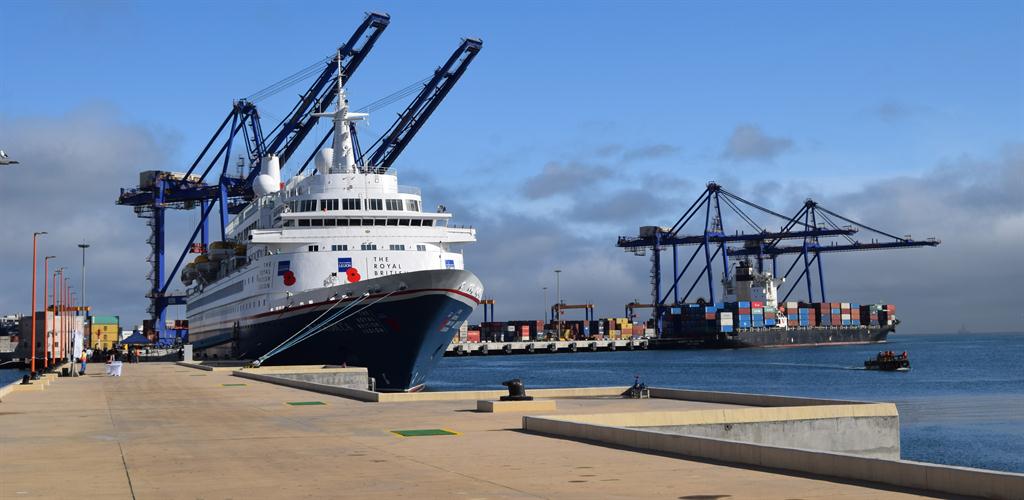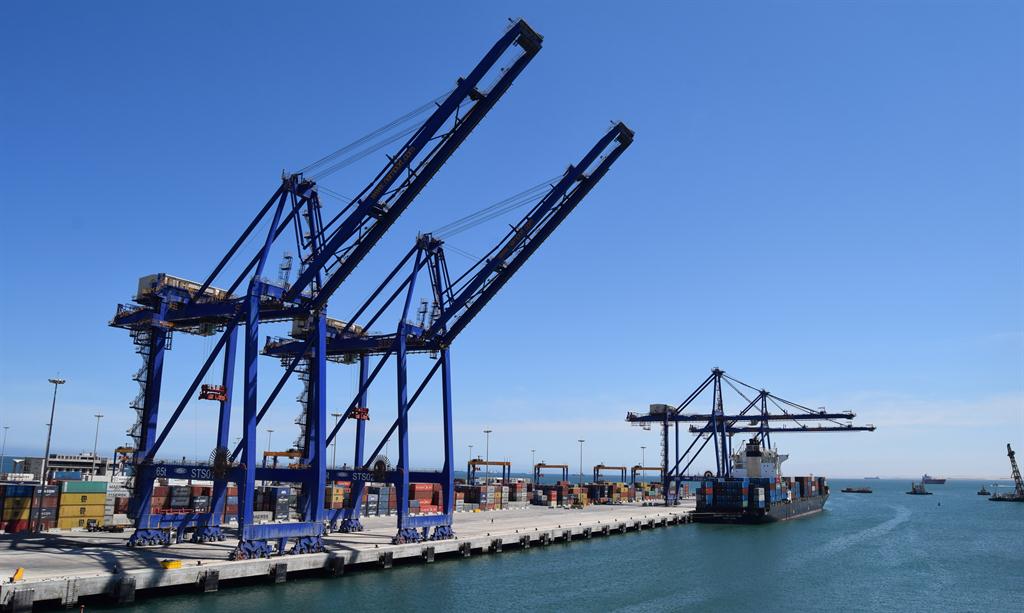SADC’s pride
The new container terminal commissioned by the Port of Walvis Bay in August gives Namibia an even greater competitive edge.
LEANDREA LOUW
Namibia has now joined countries such as Australia, Brazil, Dubai and the Netherlands in the utilisation of reclaimed land for port expansion.
The container terminal built on reclaimed land by the Namibia Ports Authority (Namport) was inaugurated by President Hage Geingob in August this year.
According to Elias Mwenyo, Namport’s manager for business development, the new container terminal is more competitive than other ports in the region because of its increased capacity.
“Since vessels are getting bigger, ports that do not follow suit in expanding their infrastructure in order to accommodate such vessels face challenges. We therefore pride ourselves on being in the big league, making us one of the key players along the West-Coast of Africa,” Mwenyo says.
Currently, the port of Walvis Bay can handle 800 000-plus Twenty-Foot Equivalent Units (TEUs).
Mwenyo explains that a range of general opportunities exist with the expanded container terminal.
“There’s definitely an opportunity to upskill our staff. Just recently, 33 employees graduated as ship-to-shore (STS) crane operators. The STS cranes were acquired by Namport to the tune of N$440 million to shorten the turnaround time for ships.
“Furthermore, the industry is fast moving with technology and will require us to move along with it. In terms of other service provisions around the port, we will require more trucking capacity to come on board, so that will also be a driver in creating employment.
“Logistics service providers will also be crucial as we will need ‘runners’ to facilitate the administration of moving cargo through the port of Walvis Bay. More capacity will be needed at the border posts to clear trucks as our port is built as a gateway serving an interlinked market, which also creates more opportunities, so there are many spin-offs.”
He explains that the port is setting the pace for infrastructural development.
“The development of the port’s infrastructure is likely to influence the developments of other modes of transport such as rail and road in order to maintain the standard set by the port.”
The container terminal was built at a cost of N$4.2 billion and increased the port’s capacity from 350 000 TUEs to 800 000 TUEs per year.
Acting CEO of Namport Kavin Harry says the inauguration of the new container terminal is the advent of a new era for Walvis Bay and the Southern African Development Community (SADC) region.
“The project entailed the creation of 40 hectares of new land, reclaimed from the bay within Namport’s current port jurisdiction by dredging and deepening the port. The sand obtained from deepening was used to form the new land, now called the new container terminal. The reclaimed land is linked to the existing port land by a causeway and consists of quay walls, paved areas, buildings, roads, railway lines, ship-to-shore quay cranes and rubber-tyre gantry cranes.”
He says the project not only provides increased container handling capacity in the port, but also increases the port’s bulk and break-bulk handling capacity by freeing up the existing container terminal to become a multi-purpose terminal.
“Critical to the overall rollout of this project was the simultaneous development of a new railway line and road linked to the existing national infrastructure, which ultimately connects the Port of Walvis with our landlocked counterparts in the SADC region through the Walvis Bay logistics corridors, which comprise the Trans-Kalahari, Walvis Bay-Ndola-Lubumbashi Developmental and the Trans-Kunene corridors.”
Funding for the project was granted by the African Development Bank (AfDB), having secured a sovereign guaranteed loan of N$2.9 billion in 2013. In addition, the AfDB advanced about N$ 2.3 million to the Namibian government to encourage companies to invest in the infrastructure and systems required to provide port users with a wider range of value-added freight and logistics services.
Elzevir Gelderbloem, project manager of the new container terminal, says to keep up with the growing demand in the port, several project options were analysed before settling on expanding the port on reclaimed land.
“We had the option to do nothing; extend Berth 1 into the adjacent fishing factory, which would have cost us N$350 million to relocate the factory; or the complete reconstruction of the existing terminal and land reclamation in the southern part of the port.
“Building the port on reclaimed land created minimal disruption to normal port operations during construction, as well as huge room for future expansion by simply adding onto the reclaimed land. This was the only option which offered the increase of all cargo-handling capacity, not just containers.”
He says revised traffic forecasts show that this capacity will be sufficient for the next few decades. When the actual throughput reaches 65% of capacity, a new project will be implemented to increase container-handling capacity once more.
Namibia has now joined countries such as Australia, Brazil, Dubai and the Netherlands in the utilisation of reclaimed land for port expansion.
The container terminal built on reclaimed land by the Namibia Ports Authority (Namport) was inaugurated by President Hage Geingob in August this year.
According to Elias Mwenyo, Namport’s manager for business development, the new container terminal is more competitive than other ports in the region because of its increased capacity.
“Since vessels are getting bigger, ports that do not follow suit in expanding their infrastructure in order to accommodate such vessels face challenges. We therefore pride ourselves on being in the big league, making us one of the key players along the West-Coast of Africa,” Mwenyo says.
Currently, the port of Walvis Bay can handle 800 000-plus Twenty-Foot Equivalent Units (TEUs).
Mwenyo explains that a range of general opportunities exist with the expanded container terminal.
“There’s definitely an opportunity to upskill our staff. Just recently, 33 employees graduated as ship-to-shore (STS) crane operators. The STS cranes were acquired by Namport to the tune of N$440 million to shorten the turnaround time for ships.
“Furthermore, the industry is fast moving with technology and will require us to move along with it. In terms of other service provisions around the port, we will require more trucking capacity to come on board, so that will also be a driver in creating employment.
“Logistics service providers will also be crucial as we will need ‘runners’ to facilitate the administration of moving cargo through the port of Walvis Bay. More capacity will be needed at the border posts to clear trucks as our port is built as a gateway serving an interlinked market, which also creates more opportunities, so there are many spin-offs.”
He explains that the port is setting the pace for infrastructural development.
“The development of the port’s infrastructure is likely to influence the developments of other modes of transport such as rail and road in order to maintain the standard set by the port.”
The container terminal was built at a cost of N$4.2 billion and increased the port’s capacity from 350 000 TUEs to 800 000 TUEs per year.
Acting CEO of Namport Kavin Harry says the inauguration of the new container terminal is the advent of a new era for Walvis Bay and the Southern African Development Community (SADC) region.
“The project entailed the creation of 40 hectares of new land, reclaimed from the bay within Namport’s current port jurisdiction by dredging and deepening the port. The sand obtained from deepening was used to form the new land, now called the new container terminal. The reclaimed land is linked to the existing port land by a causeway and consists of quay walls, paved areas, buildings, roads, railway lines, ship-to-shore quay cranes and rubber-tyre gantry cranes.”
He says the project not only provides increased container handling capacity in the port, but also increases the port’s bulk and break-bulk handling capacity by freeing up the existing container terminal to become a multi-purpose terminal.
“Critical to the overall rollout of this project was the simultaneous development of a new railway line and road linked to the existing national infrastructure, which ultimately connects the Port of Walvis with our landlocked counterparts in the SADC region through the Walvis Bay logistics corridors, which comprise the Trans-Kalahari, Walvis Bay-Ndola-Lubumbashi Developmental and the Trans-Kunene corridors.”
Funding for the project was granted by the African Development Bank (AfDB), having secured a sovereign guaranteed loan of N$2.9 billion in 2013. In addition, the AfDB advanced about N$ 2.3 million to the Namibian government to encourage companies to invest in the infrastructure and systems required to provide port users with a wider range of value-added freight and logistics services.
Elzevir Gelderbloem, project manager of the new container terminal, says to keep up with the growing demand in the port, several project options were analysed before settling on expanding the port on reclaimed land.
“We had the option to do nothing; extend Berth 1 into the adjacent fishing factory, which would have cost us N$350 million to relocate the factory; or the complete reconstruction of the existing terminal and land reclamation in the southern part of the port.
“Building the port on reclaimed land created minimal disruption to normal port operations during construction, as well as huge room for future expansion by simply adding onto the reclaimed land. This was the only option which offered the increase of all cargo-handling capacity, not just containers.”
He says revised traffic forecasts show that this capacity will be sufficient for the next few decades. When the actual throughput reaches 65% of capacity, a new project will be implemented to increase container-handling capacity once more.






Comments
Namibian Sun
No comments have been left on this article